
Robert I, popularly known as Robert the Bruce, was King of Scots from 1306 to his death in 1329. One of the most renowned warriors of his generation, Robert eventually led Scotland during the First War of Scottish Independence against England. He fought successfully during his reign to regain Scotland's place as an independent kingdom and is now revered in Scotland as a national hero.

The Wars of Scottish Independence were a series of military campaigns fought between the Kingdom of Scotland and the Kingdom of England in the late 13th and early 14th centuries.
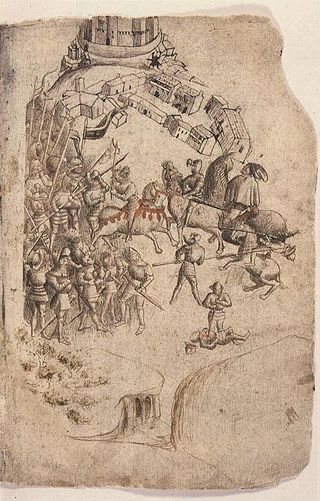
The Battle of Bannockburn fought on 23–24 June 1314, was a victory of the army of King of Scots Robert the Bruce over the army of King Edward II of England in the First War of Scottish Independence. It was a major turning point in the war, which only officially ended 14 years later with the de jure restoration of Scottish independence under the Treaty of Edinburgh–Northampton; for this reason, Bannockburn is considered a landmark moment in Scottish history.
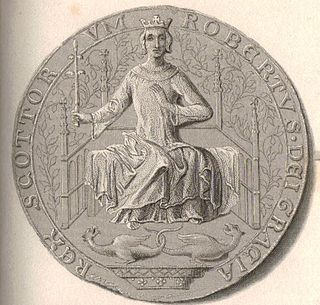
Robert II was King of Scots from 1371 to his death in 1390. The son of Walter Stewart, 6th High Steward of Scotland, and Marjorie, daughter of King Robert the Bruce, he was the first monarch of the House of Stewart. Upon the death of his uncle David II, Robert succeeded to the throne.
The Battle of Halidon Hill took place on 19 July 1333 when a Scottish army under Sir Archibald Douglas attacked an English army commanded by King Edward III of England and was heavily defeated. The year before, Edward Balliol had seized the Scottish Crown from five-year-old David II, surreptitiously supported by Edward III. This marked the start of the Second War of Scottish Independence. Balliol was shortly expelled from Scotland by a popular uprising, which Edward III used as a casus belli, invading Scotland in 1333. The immediate target was the strategically-important border town of Berwick-upon-Tweed, which the English besieged in March.

Sir James Douglas was a Scottish knight and feudal lord. He was one of the chief commanders during the Wars of Scottish Independence.

Thomas Randolph, Earl of Moray was a soldier and diplomat in the Wars of Scottish Independence, who later served as regent of Scotland. He was a nephew of Robert the Bruce, who created him as the first earl of Moray. He was known for successfully capturing Edinburgh Castle from the English, and he was one of the signatories of the Declaration of Arbroath.

The First War of Scottish Independence was the first of a series of wars between English and Scottish forces. It lasted from the English invasion of Scotland in 1296 until the de jure restoration of Scottish independence with the Treaty of Edinburgh–Northampton in 1328. De facto independence was established in 1314 at the Battle of Bannockburn. The wars were caused by the attempts of the English kings to establish their authority over Scotland while Scots fought to keep English rule and authority out of Scotland.
Walter Stewart was the 6th Hereditary High Steward of Scotland and was the father of King Robert II of Scotland, the first Stewart monarch.
The Battle of Myton, nicknamed the Chapter of Myton or The White Battle because of the number of clergy involved, was a major engagement in the First Scottish War of Independence, fought in Yorkshire on 20 September 1319.
Sir Archibald Douglas was a Scottish nobleman, Guardian of Scotland, and military leader. He is sometimes given the epithet "Tyneman", but this may be a reference to his great-nephew Archibald Douglas, 4th Earl of Douglas. He fought and died at the Battle of Halidon Hill.

Sir William Douglas, Lord of Liddesdale, also known as the Knight of Liddesdale and the Flower of Chivalry, was a Scottish nobleman and soldier active during the Second War of Scottish Independence.
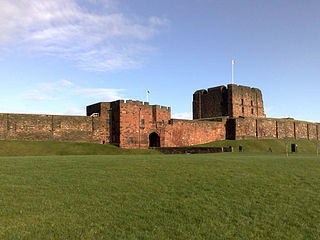
The siege of Carlisle took place from 22 July to 1 August 1315, during the First War of Scottish Independence, near the town of Carlisle, in Cumbria, England.
Cupar Castle was a royal castle at Cupar, Fife, Scotland. It was located on a small hill or motte that is known as Castle Hill next to Castlehill Primary School in Cupar. No vestiges of the castle remain above ground.
Sir Andrew Murray (1298–1338), also known as Sir Andrew Moray, or Sir Andrew de Moray, was a Scottish military and political leader who supported King David II of Scotland against Edward Balliol and King Edward III of England during the Second War of Scottish Independence. He held the lordships of Avoch and Petty in north Scotland, and Bothwell in west-central Scotland. In 1326 he married Christina Bruce, a sister of King Robert I of Scotland. Murray was twice chosen as Guardian of Scotland, first in 1332, and again from 1335 on his return to Scotland after his release from captivity in England. He held the guardianship until his death in 1338.
Sir William Keith of Galston was a Scottish Knight who fought in the Wars of Scottish Independence. He brought the bones and heart of James Douglas, as well as King Robert I of Scotland's heart, back to Scotland after Douglas was killed on crusade in Spain.
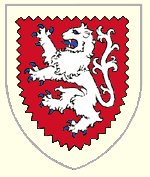
Sir Thomas Grey of Heaton Castle in the parish of Cornhill-on-Tweed, Northumberland, was a soldier who served throughout the Wars of Scottish Independence. His experiences were recorded by his son Thomas Grey in his chronicles, and provide a rare picture of the day to day realities of the Wars.
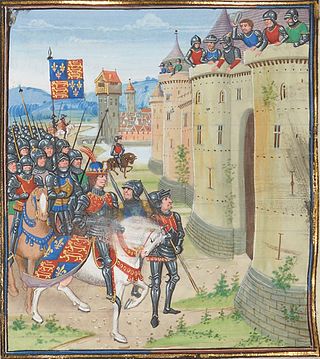
The siege of Berwick lasted four months in 1333 and resulted in the Scottish-held town of Berwick-upon-Tweed being captured by an English army commanded by King Edward III. The year before, Edward Balliol had seized the Scottish Crown, surreptitiously supported by Edward III. He was shortly thereafter expelled from the kingdom by a popular uprising. Edward III used this as a casus belli and invaded Scotland. The immediate target was the strategically important border town of Berwick.
Sir William Prendergast was a knight who fought in the Wars of Scottish Independence. He fought on both the English and Scottish sides and was killed while fighting on the Scottish side during the Battle of Halidon Hill.
The sieges of Berwick were the Scottish capture of the town of Berwick-upon-Tweed on 6 November 1355 and their subsequent unsuccessful siege of Berwick Castle, and the English siege and recapture of the town in January 1356. In 1355 the Second War of Scottish Independence had been underway for over 22 years. After a period of quiescence the Scots, encouraged by the French who were fighting the English in the Hundred Years' War, assembled an army on the border. In September a truce was agreed and much of the English army left the border area to join King Edward III's campaign in France.











